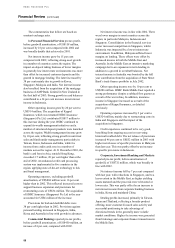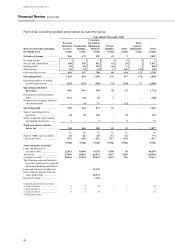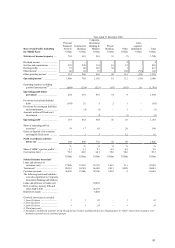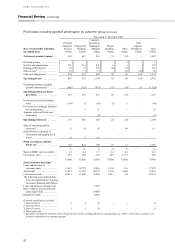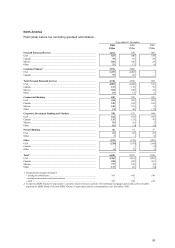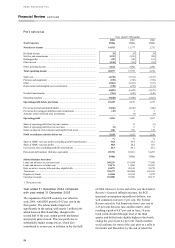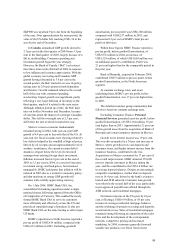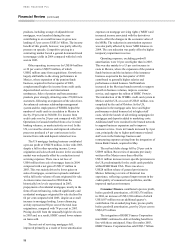HSBC 2004 Annual Report Download - page 100
Download and view the complete annual report
Please find page 100 of the 2004 HSBC annual report below. You can navigate through the pages in the report by either clicking on the pages listed below, or by using the keyword search tool below to find specific information within the annual report.
HSBC HOLDINGS PLC
Financial Review (continued)
98
collections, and the move into prime and near-prime
markets. Improvements in delinquency were seen
across most products and in a number of key
indicators, including early stage delinquency, charge-
offs and year-on-year bankruptcy filings. The rate of
improvement declined in the second half of the year
reflecting seasonality, a slowdown in employment
growth and rising energy prices.
Commercial Banking reported pre-tax profits,
before amortisation of goodwill, of US$845 million
for 2004, an improvement of 41 per cent over 2003.
Net interest income increased by 8 per cent, of
which 3 per cent was attributable to the acquisition
of Bank of Bermuda. Adjusting for the loss of net
interest income following the disposal of the US
equipment-leasing portfolio last year, underlying
growth was 7 per cent.
In the US, the recruitment of 50 additional
relationship managers, focusing on the SME market,
contributed to a 12 per cent rise in lending balances
and a 17 per cent increase in commercial deposits.
Improved economic conditions and stronger
consumer confidence also led to increased demand
for credit, but spreads suffered in the competitive
marketplace. Commercial real estate lending
increased by 11 per cent, largely as a result of
expansion into the US West Coast and Miami.
In Canada, net interest income increased by
16 per cent. Growth in lending reflected stronger
demand for credit in the low interest rate
environment, improved market conditions and
additional income following the integration of Intesa
Bank. In Mexico, competitors displaying a greater
appetite for risk enabled HSBC to selectively reduce
loan balances. This, together with the effect of lower
interest rates on deposit spreads and a restructuring
of prices, which emphasised fees at the expense of
margin, led to an 11 per cent reduction in Mexican
net interest income.
Other operating income was US$13 million or
3 per cent higher than in 2003. Excluding the
disposal of the US factoring and equipment leasing
businesses, which in 2003 contributed other
operating income of US$109 million, the underlying
growth was 25 per cent. The impact of acquisitions
during 2004 was not material.
In Mexico, fees and commissions grew by
US$10 million or 11 per cent. Fees earned from
payments and cash management and electronic
banking both increased. The Mexican authorities
changed the tax regulations to require all companies
to make tax payments via electronic banking
channels from January 2004. HSBC seized the
opportunities presented by this change to increase
both the number of clients using electronic banking,
and the number of transactions and income per
client. Earnings from new trade services products
and increased loan fees (from the price restructuring)
also contributed.
Operating expenses declined by 6 per cent
compared with 2003 as a result of the disposal of the
factoring and equipment leasing businesses in the
US. Adjusting for this, there was a 3 per cent rise in
expenses reflecting additional costs from the
restructuring and integration of Intesa Bank, the
inclusion of Bank of Bermuda, and the effect of
increased transaction volumes and business flows
between Mexico and the US.
The charge for bad and doubtful debts fell by 90
per cent to US$13 million, reflecting an improved
economic environment and falling corporate default
rates. In 2003, the charge included US$33 million in
the US factoring and leasing businesses which were
sold during that year.
Corporate, Investment Banking and Markets
reported pre-tax profit, before amortisation of
goodwill, of US$750 million, 11 per cent lower than
in 2003.
Net interest income was 11 per cent lower than
in 2003, notwithstanding the first contribution from
Bank of Bermuda, which added US$31 million, or 4
per cent to the total. In part this reflected the cost of
funding trading strategies where the offsetting
income arises within dealing revenues. The return on
investments held for liquidity fell and the yield on
loans dropped as re-financing reached record levels
following the reductions in interest rates in the latter
part of 2003 and early 2004. The lower interest rates
resulted in large early redemptions of mortgage-
backed securities. Reinvestment opportunities,
however, failed to match the yields given up on these
redemptions. In Canada, a combination of interest
rate cuts in the early part of 2004 and lower
corporate loan balances reduced net interest income.
However, in Mexico, investment portfolios profited
from having locked into higher long-term interest
rate structures.
Other operating income improved by 15 per
cent, of which 7 per cent was attributable to Bank of
Bermuda, which improved its market share in funds
administration following its acquisition. A 23 per
cent increase in fees and commissions in the US was
driven by increased underwriting fees from debt
issues and syndication, coupled with higher deal
execution revenues. Increased revenues from
customers reflected improved client coverage. The
growing use of electronic trading by clients resulted


